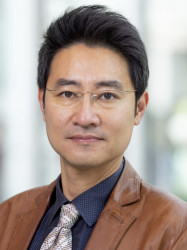Summary
Po-Heng (Henry) Lee's team specialises in resource recovery, greenhouse gas reduction, and enhancing human health through the application of anaerobic biotechnologies, including anaerobic sewage treatment, anaerobic digestion, fermentation, and anaerobic ammonium oxidation (Anammox). His research and teaching have been primarily focused on transcending classical energetics limitations by exploring discrete (quantum and quantum-like) pathways within microbial metabolism and gene regulation.
His current research interests encompass two main areas:
- Achieving superior antibiotics and nitrogen removal, producing value-added chemicals, and generating energy through the interactions between microbiomes and conductive materials under micro-aeration conditions.
- Procrastination and optimisation of full-scale wastewater treatment plants using quantum computing.
Henry has developed state-of-the-art research techniques, including the use of quantum computing with the IBM Qiskit platform (such as Quantum Information Theory and Variational Quantum Eigensolver) and hybrid meta-omics approaches. These methods enable the manipulation of microbiomes to promote a healthier environment.
Henry's academic journey includes earning his PhD, MS, BS, and AAS degrees in Environmental Engineering from Iowa State University (2010), the USA, National Chiao Tung University (2003), National Ilan University (2001), and Hungkuang University (1999), Taiwan, respectively. He joined Imperial College London in 2019 after holding positions at the Hong Kong Polytechnic University (2012-2018) and Inha University, South Korea (2010-2012).
Keywords: Environmental Biotechnology; Meta-omics; Open Quantum System; Quantum computing; Electron/Proton Tunnelling and Hopping
Selected Publications
- Uali, A.S., Lam, T.Y.C, Huang, X., Wu, Z., Shih, H.J., Tan, G.Y.A. Lee, P.H.* 2023. Role and potential of the semi-classical/-quantum mechanism of the extracellular environment and cell envelope in Direct Interspecies Electron Transfer (DIET)-driven biomethanation. Cr. Rev. Env. Sci. & Techno. 9. 1-21
- Wu, Z.,* Nguyen, D., Shrestha, S., Raskin, L., Khanal, S.K., Lee, P.H.** 2023 Evaluation of Nanaerobic Digestion as a Mechanism to Explain Surplus Methane Production in Animal Rumina and Engineered Digesters. Env. Sci. & Techno. 57, 33, 12302–12314
- Rao, R., Hu, J., Lee, P.H.* 2022. Theoretical characterisation of electron tunnelling from granular activated carbon to electron accepting organisms in direct interspecies electron transfer. Sci. Rep. 12, 12426.
- Wu, Z., Nguyen, D., Lam, T.Y.C., Zhuang, H., Shrestha, S., Raskin, L., Khanal, S.*, Lee, P.H.** 2021. Synergistic association between cytochrome bd-encoded Proteiniphilum and reactive oxygen species (ROS)-scavenging methanogens in microaerobic-anaerobic digestion of lignocellulosic biomass. Water Res. 116721.
- Lam, T.Y.C., Mei, R., Wu, Z., Lee, P.K.H., Liu, W.T.*, Lee, P.H.** 2020. Superior resolution characterisation of microbial diversity in anaerobic digesters using full-length 16S rRNA gene amplicon sequencing. Water Res. 115815.
- Leng, L., Nobu, K.M., Narihiro, T., Yang, P.X., Tan, G.Y., Lee, P.H.* 2019. Shaping microbial consortia in coupling glycerol fermentation and carboxylate chain elongation for co-production of 1, 3-propanediol and caproate: Pathways and Mechanisms. Water Res. 148. 281-291.
- Yang, P., Tan, A., Aslam, M., Kim, J., Lee, P.H.* 2019. Metatranscriptomic evidence for classical and RuBisCO-mediated CO2 reduction to methane facilitated by direct interspecies electron transfer in a methanogenic system. Sci. Rep. 9 (1), 4116.
- Ji, X., Wu, Z., Sung, S., Lee, P.H.* 2019. Metagenomics and metatranscriptomics analyses reveal oxygen detoxification and mixotrophic potentials of an enriched anammox culture in a continuous stirred-tank reactor. Water Res. 166. 115039.
Publications
Journals
Uali AS, Lam TYC, Huang X, et al., 2024, Role and potential of the semi-classical/-quantum mechanism of the extracellular environment and cell envelope in Direct Interspecies Electron Transfer (DIET)-driven biomethanation, Critical Reviews in Environmental Science and Technology, Vol:54, ISSN:1064-3389, Pages:581-601
Bai Y, Hu H, Lee P-H, et al., 2023, Nitrate removal in iron sulfide-driven autotrophic denitrification biofilter: Biochemical and chemical transformation pathways and its underlying microbial mechanism., Sci Total Environ, Vol:901
Wu Z, Nguyen D, Shrestha S, et al., 2023, Evaluation of Nanaerobic Digestion as a Mechanism to Explain Surplus Methane Production in Animal Rumina and Engineered Digesters, Environmental Science & Technology, Vol:57, ISSN:0013-936X, Pages:12302-12314
Yang P, Leng L, Zhuang H, et al., 2023, Significant enhancement by casamino acids of caproate production via chain elongation, Biochemical Engineering Journal, Vol:193, ISSN:1369-703X
Bai Y, Wang S, Zhussupbekova A, et al., 2023, High-rate iron sulfide and sulfur-coupled autotrophic denitrification system: Nutrients removal performance and microbial characterization, Water Research, Vol:231, ISSN:0043-1354

